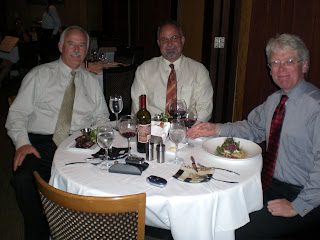
I think that part of the problem is that often in DC, my dinners are working dinners. We don’t necessarily pick a restaurant for its innovative food, and since we spend the meal talking business, I don’t always do a good job of noting my reactions to the food.
Well, not this time. Today I’m writing about Poste Brassiere, located in the Hotel Monaco in the Penn Quarter neighborhood of
Based on what I’d read, I described the place to the other diners as ‘innovative American.’ I was challenged to define what that meant. Poste describes itself as contemporary brasserie – hardly more descriptive. I still think my description is more accurate. Traditionally, a French brasserie is more formal than a bistro but doesn’t have all of the features of a full-fledged restaurant. Often at a brassiere, menu items are complete meals rather than individual courses like you see at a restaurant.
But the fact is that in
When I describe Poste as ‘innovative
The three of us started by splitting two appetizers – a grilled kielbasa cut into thirds and a very nice selection of house-made charcuterie. The starters overcame any hesitancy my friends might have had about Poste; they quit caring if it was ‘innovative American’ or ‘contemporary brasserie.’ I thought the charcuterie plate was particularly good. The selection offered a nice variety of styles, and the flavors were also varied,
Both of my compatriots had the hanger steak and ‘pommes frites.’ Hanger steak is a traditional bistro fare. My carnivorous friends loved the steak served at Poste. It was tender, excellently prepared, very flavorful. Pommes frites are often defined as French fries. But the wonderfully prepared, crisp potatos served with the steak at Poste bore very little resemblance to the typical, greasy, mealy fries served at many American restaurants. These were truly exceptional. When we ordered, our server asked if we wanted the frites to be sprinkled with parmesan cheese. Hey! She was talking to a milk producer and a couple of Land O'Lakes staff. Of course we wanted them with parmesan. Wow! That was a fabulous addition.
I decided to go for a fish entrée. I ordered wild bass served with a potato mash (the menu calls it ‘champ’ potatoes) and caper beurre noisette. I didn’t know what that sauce was either. It was light and nutty and the capers added a tangy flavor that really enhanced the fish. So as I was writing this blog, I looked it up. Beurre noisette is a simple butter sauce. The butter is cooked over a gentle heat until the solids separate and begin to brown. It was a great meal.
One of our group was from
My rep as a restaurant picker in DC was maintained. Poste Brasserie – give it a try.








